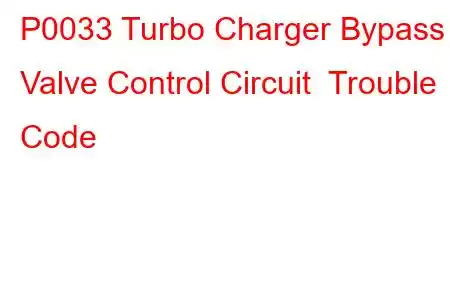P0033 Turbo Charger Bypass Valve Control Circuit
OBD-II Trouble Code Technical Description
Turbo Charger Bypass Valve Control Circuit
What does that mean?
This diagnostic trouble code (DTC) is a generic OBD-II powertrain code. It is considered generic because it applies to all makes and models of vehicles (1996-newer), although specific repair steps may vary depending on the make and model.
Owners of these these brands may include but are not limited to VW, Dodge, Saab, Pontiac, Ford, GM, etc.
If this code has been stored it means that the powertrain control module (PCM) has received an input signal from the turbocharger bypass valve control circuit that is not within programmed specifications.
The turbocharger bypass valve is usually controlled by the PCM or boost controller. The boost controller is sometimes a stand-alone controller but more frequently it is an integrated part of the PCM. Input data from various turbocharger and engine control sensors is calculated by the PCM to determine the desired position of the turbocharger bypass valve. The turbocharger bypass valve is used to (electronically) regulate boost pressure before it enters the engine intake manifold.
The bypass control valve is actuated using a small electronic motor (or vacuum control valve). The motor receives output voltage/ground signals from the boost controller or PCM. The signal wire of the turbo boost control circuit enables the PCM to monitor system voltage. If voltage is not within a predetermined range, the PCM detects it and this code is stored. A service/check engine lamp may also be illuminated.
Since the conditions for causing this code to be stored could lead to excessive turbocharger boost pressure, it should be addressed with some degree of urgency.
Symptoms
Symptoms of a P0033 engine code may include:
Reduced engine performance Whining or rattling noises from the turbocharger or turbo pipes Excessive smoke from the exhaust Fouled spark plugs Elevated engine and/or transmission temperature Abnormal hissing noises from the turbocharger wastegate and/or hoses Additional codes may also be stored, including turbocharger boost related codes, engine misfire codes, or knock sensor codes Due to elevated engine temperatures, cylinder detonation is also a distinct possibility If applicable, the boost pressure gauge may also exhibit abnormal levels of boost pressure.Causes
Potential causes for this code to set are:
Bad turbocharger bypass valve actuator Defective turbocharger bypass valve Disconnected, cracked, or collapsed vacuum line (vacuum actuated bypass valve) Faulty boost pressure sensor Shorted or open wiring in the boost sensor circuit Loose, corroded, or disconnected electrical connectors in the boost sensor reference circuit Defective PCM or boost controller.Diagnostic and Repair Procedures
A good starting point is always to check for technical service bulletins (TSB) for your particular vehicle. Your issue may be a known issue with a known fix put out by the manufacturer and can save you time and money during diagnosis.
Factory turbocharger boost pressure usually ranges between nine and fourteen pounds but check manufacturer’s specifications for your vehicle. Test boost pressure to make sure that it is sufficient. If boost pressure is low, internal turbocharger repair or turbocharger replacement may be necessary. Also check turbo hoses and exhaust components for leakage.
There are two basic designs of turbo boost control valves. In the first design, the valve is actuated using engine vacuum. An electronically controlled vacuum control valve provides vacuum to open the boost control valve, which is closed after vacuum is restricted. Typically, the vacuum control valve (or solenoid) is supplied with battery voltage and the PCM (or boost controller) provides a ground signal w
Read: 47


